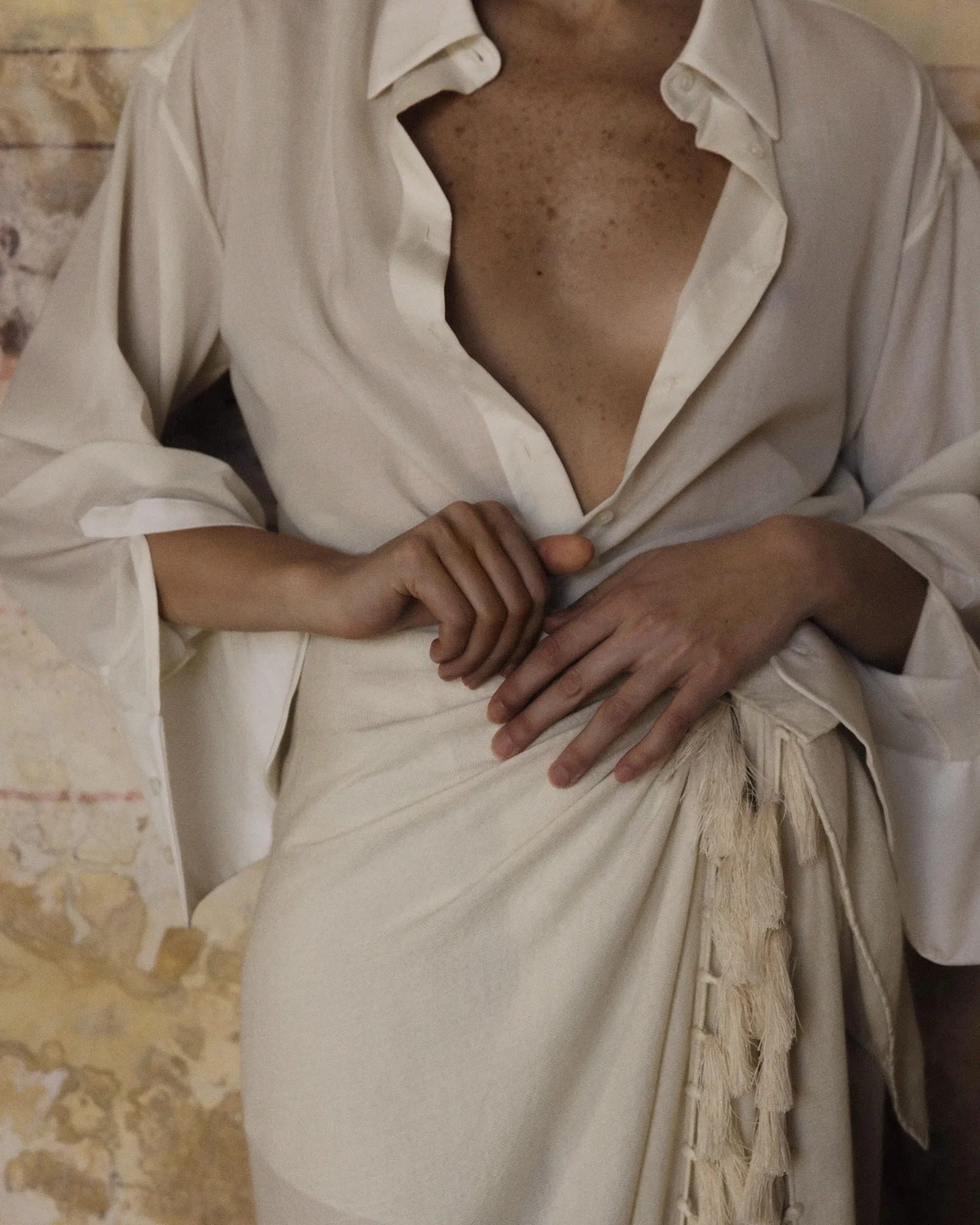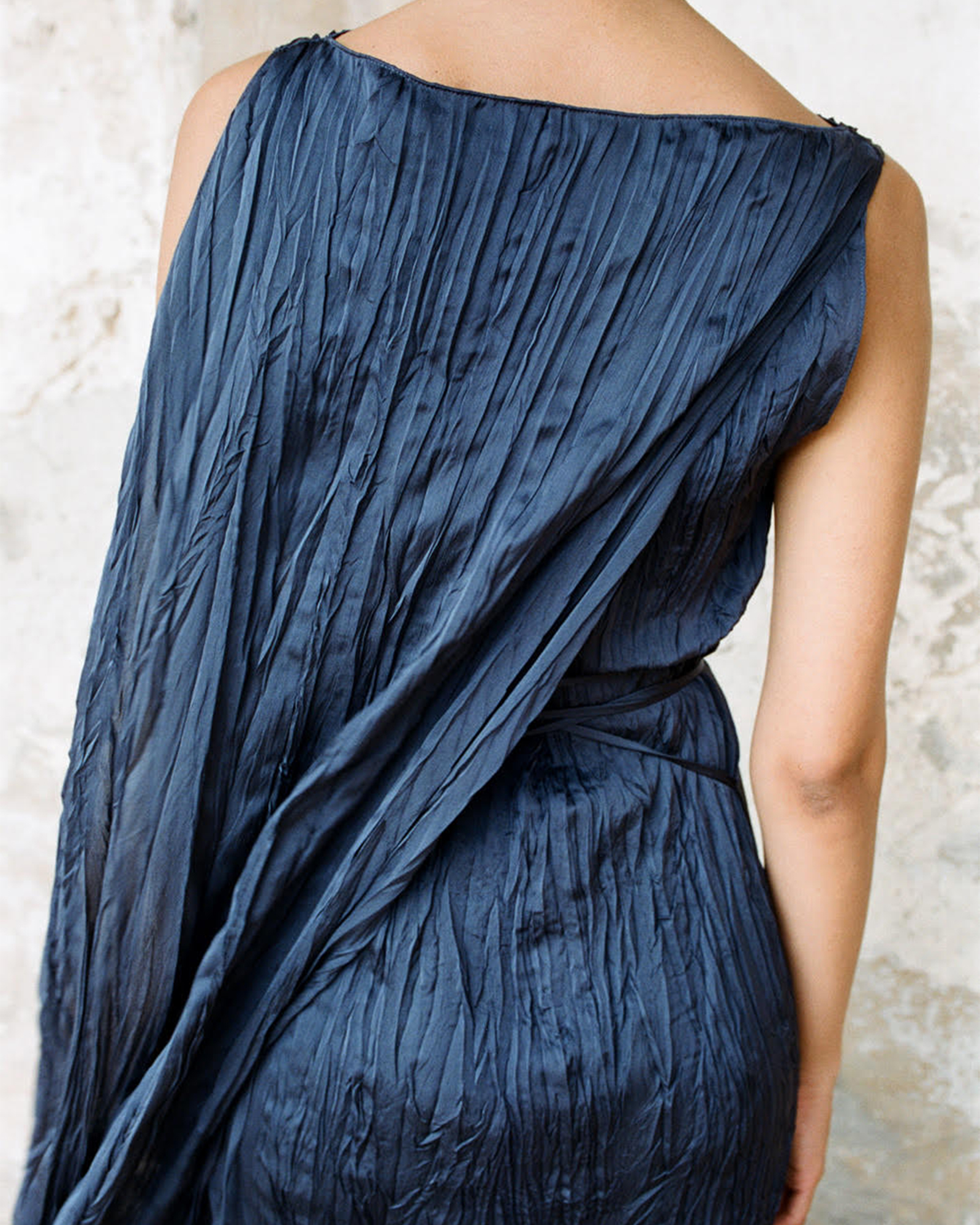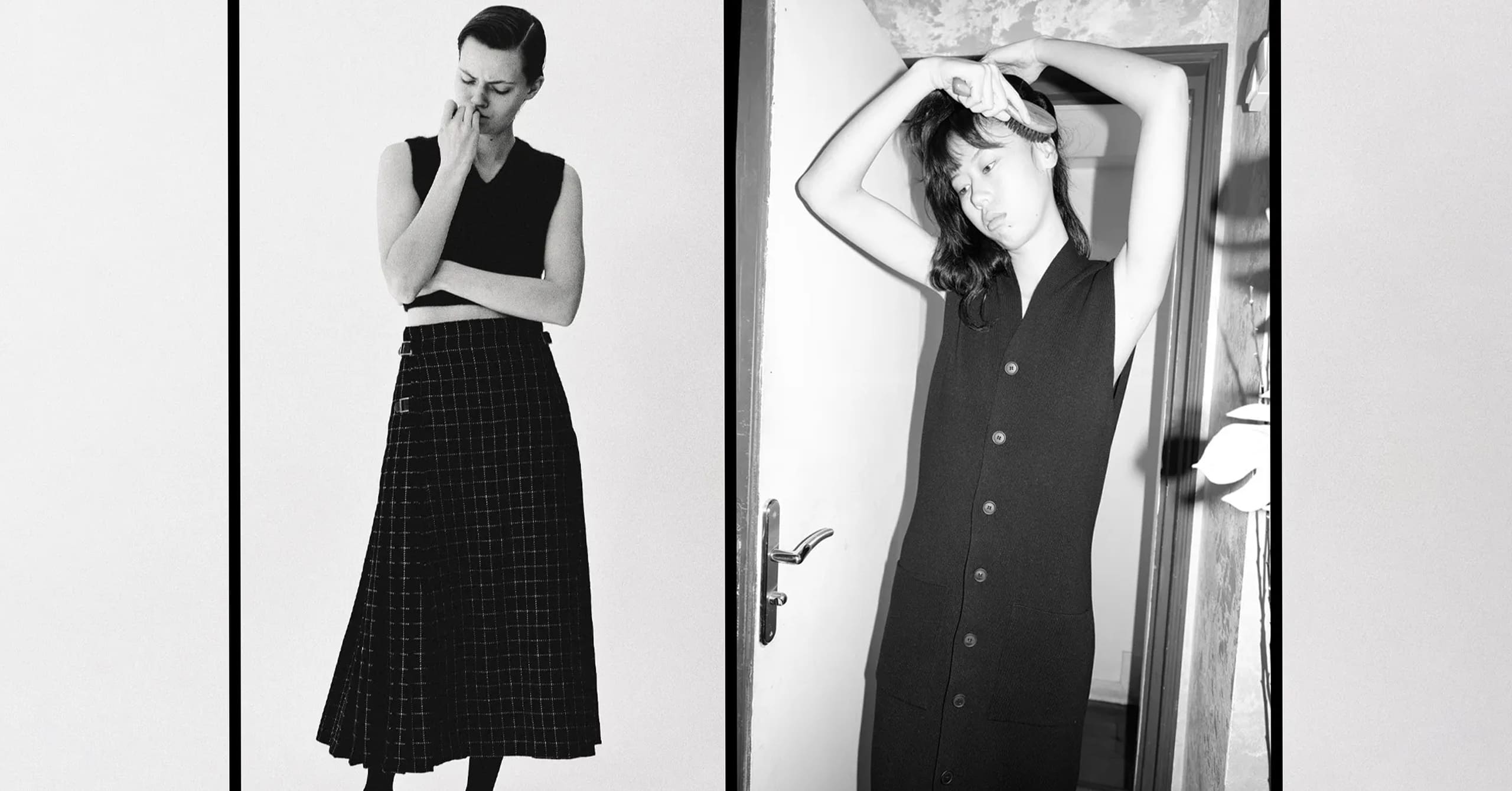Old Stone Trade and Cristaseya are two women-led lables that focus on creating season-less clothes and have carved a niche in the way they approach their sales. Photos left to right: Anastasiia Duvalli/ Courtesy of Old Stone Trade; and Andrea Spotorno/ Courtesy of Cristaseya
The excitement over Phoebe Philo’s impending return to fashion is enough to make at least several organized religions shake in their sumptuous robes. Reports of her comeback were confirmed in February, with the appearance of a simple Instagram account and a single post offering sparse details: A website would soon launch where interested parties could sign up to buy from her namesake line (the posts have since been deleted to maintain the air of mystery and exclusivity). And so it was off to the races for Philo’s fans and the media that feeds off of such an elusive personality.
The thing about Philo is that—like so many other giants who suddenly disappeared from their milieu—a larger cult formed around her in absentia. Philo came into the scene as Stella McCartney’s assistant in 1997, when—fresh out of Central Saint Martins—McCartney was given the top spot at Chloé after Karl Lagerfeld’s departure. They were two young and cheeky British girls who liked to party and have fun; and those early collections reflect that. Five years later, Philo inherited the French maison when McCartney left to set up her namesake label, and she quickly established a vision that was frilly and feminine but rooted in the practical. Her babydoll dresses, high-waist flare jeans, and wooden platforms turned out to be exactly what young women wanted to wear. She was swiftly crowned “a woman’s designer,” with everyone keen to point out that she had been the first designer to take maternity leave while at the top job.
When she was eventually named creative director at Celine in 2008, it was with a caveat that they let her work from London so that she could be close to her family. It was here that she achieved her final form. Freed from the constraints of a house code, her clothes began to reflect not only her own approach to dressing, but also her preoccupations and other esoteric interests. Although today “Phoebe Philo Celine” is shorthand for a plain and minimalist—yet oftentimes oversized—wardrobe of beige, black, or white, her best and most memorable collections were streaked with bold color, given to deep romanticism and emotion, or sometimes featured diehard detours towards retro design movements (the Memphis collection).
For almost a decade, Philo was an oracle for women in fashion, and her sudden exit in 2017 was received not unlike a death. The notoriously press-averse designer left no message for her hordes of fanatics; she simply retired. Since then, Philo’s legacy has crystallized. Her influence has become the driving force for a new kind of womenswear that’s considered and practical, without forgoing a sense of fantasy and extravagance—even when the details are subtle.
When Philo first left the scene (almost five years ago), there was the question of “what will we do?”—a feeling that there would forever be a hole where her clothes used to be. The return of Phoebe Philo as a direct-to-consumer brand with limited drops, puts her in the company of other womenswear currently rejecting the fashion calendar to focus on small offerings that showcase their own idiosyncratic tastes, with clothes that retain an air of anonymity. It’s a testament to Philo’s own influence, and it’s almost like she’s coming full circle. Change begets change.

One of those labels is Old Stone Trade. Founded in 2021 by Melissa Ventosa Martin, the label has a slightly unorthodox approach to making clothes. The former fashion editor finds the best artisans and craftsmen responsible for making what she deems as “essential” pieces in a woman’s wardrobe—like a perfect Aran sweater knit by a collective in Kilmurvey, Ireland (the youngest of the knitters is 62); delicate lace collars handmade in Lepoglava, Croatia (where the craft has been declared as intangible cultural heritage of humanity by UNESCO); and Scottish kilts. “I was raised by my grandparents. My grandmother was Scottish, and she’d put on her kilt for special occasions, so I had a lot of her kilts that were handed down to me,” Ventosa Martin shared on a recent Zoom. “I realized there is something there with these pieces that are handmade. They’re not fashion necessarily, they’re really things that you keep that you wear forever.”
These were the same things that she found appealing about Philo’s Celine era. “I would go there for classic things because she had the perfect navy blue Aran knit sweater or a black tuxedo pant that I still wear today because it has a perfectly thick waistband that’s lined with grosgrain,” Ventosa Martin explained. “I feel like that’s something that I was really missing when she left Celine, and I do feel like a lot of smaller designers are trying to fill in the gap in a way. I certainly was motivated by that when I started Old Stone Trade,” she added. “For me, it really is about these evergreen timeless pieces.” Most of the items that are for sale on Old Stone Trade are made-to-order, but sometimes she does stock things in small quantities. “I think for luxury, the customer really wants more unique pieces and things that are more meaningful, with an emphasis on process.”


Attersee, a line of easy ready-to-wear pieces in luxe fabrics with a more everyday appeal, was also founded in 2021 by Isabel Wilkinson—another former magazine editor. Her collection of pared-back essentials hew to the quiet luxury aesthetic most commonly associated with Philo’s disciples, but her clothes are never precious or fussy. “I often felt challenged to find clothing that I could wear comfortably to work but that could also transition with me easily into the after-hours,” Wilkinson explained via email. “I felt that I was missing a supportive wardrobe for all the selves I needed to be over the course of a day or a week.” Her elongated vest tops, fringe linen dresses, and sarong skirts can all easily transition into eveningwear.



It’s possible you haven’t heard of Cristaseya, the Paris-based label founded by Cristina Casini and Keiko Seya in 2011. It is now run by Casini and her husband, Andrea Spotorno, out of an appointment-only space in the ninth arrondissement. But their clothes, with a focus on tailoring and unexpected proportions, are not the only thing making them stand out in the market—it’s their approach to sales too. Their wares, which include ready-to-wear and lifestyle objects, are available online and in their Parisian space for only a few weeks once an edition drops. At which time, customers are able to shop new and previous collections, reinforcing an ethos of “seasonal editions that last and together make the ideal wardrobe.” (Philo is rumored to be a fan.)
“The temporary online drops were not part of our initial strategy. At the time we didn’t even want to sell online—only in physical stores—because we felt you had to touch the fabrics, which are pivotal for us and the experience of our universe,” Casini explained via email. The fact that she feels so strongly about the importance of touching the fabrics makes sense, since she grew up in Northern Italy, where her mother has been running a knitwear company for the past 40 years. Cristaseya sweaters, in particular, are known to be extra special (a friend who works in PR recently texted a stack of her Cristaseya knits; “it’s a problem,” she said). “In terms of finances, sticking to the idea of only opening the online shop temporarily is still one of the hardest decisions, but it’s the only way to align with the long-term vision of the brand. The rareness and the discretion are an important part of the DNA of Cristaseya. The growth is slower, for sure, but it pays off in the long term.”
While we still don’t know what shape Phoebe Philo will take, it’s exciting to think she may be joining the ranks of other designers and entrepreneurs who are choosing to make fashion work in their own way—especially when it’s something that she often questioned during her early years. “The biggest change in womenswear in the last 10 years is still Celine by Philo, in my opinion,” said Cristaseya’s Casini. “I don’t know any other event that has impacted the fashion scene so strongly. I think Phoebe Philo won’t be something new or revolutionary, but the natural prolongation of her vision of the contemporary woman that was Celine—of course in a more mature and conscious way, because she’s had the time to analyze and put things into perspective.”
Elements of Sarah Mower’s review of Philo’s last runway show (for Celine’s spring 2018 collection) seem like they hold some clues about Philo’s vision for the future. Mower mentioned the designer’s desire to “give people comfort” by sitting them close together on benches covered with sleeping bags. “[Philo] said her research had reeled her back to the reason she’d been interested in joining Celine in the first place—the time before it had been ‘fashion’ as we know it,” Mower wrote, adding that Philo had been looking at old Celine advertisements. “[The models in the ads] were quite a lot older and proud in their feeling about clothes, so I started looking at the designers of the early ’80s, pre-AIDS. I can almost not imagine what it felt like to have that joyousness and freedom,” noted Philo at the time. Now it seems possible the industry has changed enough to allow Philo to slow down and find the joy, and perhaps more importantly, the freedom to finally be able to return to fashion on her own terms.
This article was originally published on Vogue.com
